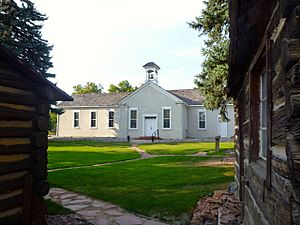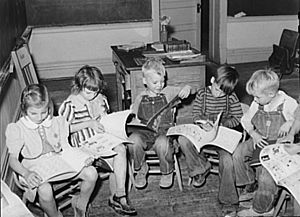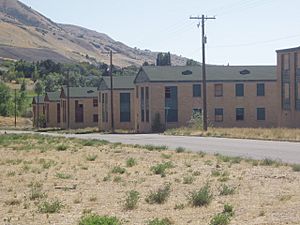Education in Utah facts for kids
Education in Utah has a rich history that has shaped its schools today. The first schools began in 1847 when Mormon pioneers settled in Utah. These early schools were mostly run by the Mormon community. Church leaders helped create what was taught and provided places for learning.
When Utah became a state in 1896, schools started getting money from the government. This meant that public school education became free for everyone. Today, Utah's education system includes public, charter, and private schools for students from kindergarten to 12th grade. There are also many public and private colleges and universities across the state.
How Education in Utah Began
Early Schools and Church Influence
Early Mormon pioneers came to what is now Utah in 1847. They were looking for a safe place to practice their religion. For the first 20 years, most schools were run by the Church of Jesus Christ of Latter-day Saints (LDS Church).
Classes often took place in church buildings. School areas usually matched the church's local ward boundaries. A local trustee, chosen by the church bishop, managed each school. Families attending the schools mostly paid for them, so funding depended on the local economy.
Because each school was independent and had different funding, the quality of education varied. Since the church supported these schools, lessons often included Mormon values and scriptures. In 1851, leaders tried to make school rules and lessons more standard. However, it took time for these changes to make a big difference.
Changes in the 1800s
In the 1860s, more Protestants and Catholics moved to Utah. This led to schools shifting from church control to government control. County leaders were put in charge, and city councils became responsible for schools. Local governments began collecting taxes to pay teachers and buy school supplies.
After the transcontinental railroad was finished in 1869, more non-Mormon groups moved to Utah. Many of these new groups wanted to change the Mormon-dominated schools. Protestants opened "mission schools" to offer private education without Mormon teachings. St. Mark's School, built in 1867, was one of the first and still exists today.
By 1870, most public schools still charged fees. This led to a strong push for free public education. The state government started using its money to help fund schools. Non-Mormon groups, who made up 20% of the population, did not like the idea of funding public schools that were still heavily influenced by the Mormon church. They called for a clear separation of church and state in schools.
In 1887, the federal government passed the Edmunds–Tucker Act. This law made many changes to the LDS Church's practices. It also ended the territorial Superintendent of Schools position. A "commissioner of schools" was then appointed to approve school content and help integrate all students and teachers. Soon after, the School Law of 1890 made public education free across the territory. When Utah became a state in 1896, this law expanded, making schools government-funded and free from religious control.
Education in the 1900s
In the 1900s, Utah became one of the first states to make education more equal across the state. In 1919, Utah passed its first laws requiring students to attend school. This led to many more students enrolling. However, this increase also brought new challenges for the state.
Church and State in Schools
The issue of church and state often came up in Utah's public schools during this time. At the start of the 20th century, Utah had very few students in private schools (only 0.5%). Some non-Mormon families felt that public schools were still too influenced by the LDS Church. The church tried to create its own private school system, but these schools eventually became public schools. This contributed to the low private school enrollment.
Money Problems and Solutions
After World War II, Utah focused on improving education again. Even with limited money, students often had above-average test scores. This was partly because Utah had a higher birth rate than other U.S. states. After the war, teachers and schools asked the government for more funding. This was hard during Governor J. Bracken Lee's time (1949–1957) because he cut budgets and did not want federal help.
By 1960, about 12% of Utah teachers moved to other states for work. This was partly due to lower salaries. Many people trained to be teachers in Utah but ended up working elsewhere. As a result, about half of Utah's teaching jobs were filled by people who were not fully certified. School buildings also needed repairs. Some school roofs even collapsed during school hours.
In May 1964, the money problems became so bad that the National Education Association (NEA) took action against Utah's education system. This was the first time the NEA had ever done this to an entire state. After Governor Cal Rampton helped solve some of these financial issues, the NEA lifted its actions in 1965. With better funding, schools improved.
In 1983, a national report said that U.S. students were doing worse than students in many other countries. This led to new education reforms in Utah and across the United States. Utah's governor, Scott Matheson, set new goals to help improve education in the state.
Indian Placement Program (1953–1996)
The Indian Placement Program was an official LDS Church program. It aimed to provide Native American children with education in schools mostly attended by white settlers. The church wanted to invite Native Americans to join the church and become part of their community.
The program invited Native American children to live with an active church family during the school year. This allowed them to attend a local school near their "foster" home. To join, children needed to be baptized members of the church, want to be educated, and keep good grades. Their parents would sign a form to allow them to participate. The church and the "foster" family would help provide for the child's needs. At its peak in the 1970s, about 5,000 students were in the program.
People had different feelings about the program. Some participants felt it helped them. Others felt it took them away from their own culture, making it hard to connect with their heritage. As schools on reservations improved in the 1980s, fewer students joined the program. The church officially ended the program in 1996.
Education in Utah Today
Schools for Kids (K-12)
Public education in Utah uses the K-12 system. This means students attend primary and secondary schools. There are three types of schools in Utah: public, charter, and private.
The Utah State Board of Education oversees all public education laws and standards. This includes public and charter schools, which receive state funding. Currently, Utah has 42 public school districts. About 666,858 students attend these schools, with a student-teacher ratio of about 21 students per teacher. The public education budget for 2020 was $5.6 billion. In 2019, the state's high school graduation rate was 87.4%.
Besides public and charter schools, there are also about 166 private schools operating in Utah.
Colleges and Universities
Utah has eight public colleges and universities that are part of the Utah System of Higher Education:
Universities
- Southern Utah University
- University of Utah
- Utah State University
- Utah Tech University
- Utah Valley University
- Weber State University
Community and Junior Colleges
- Snow College
- Salt Lake Community College
The Utah State Board of Regents governs this system. Its members are chosen by the governor.
Private colleges in Utah include Brigham Young University and Westminster College, among others.




